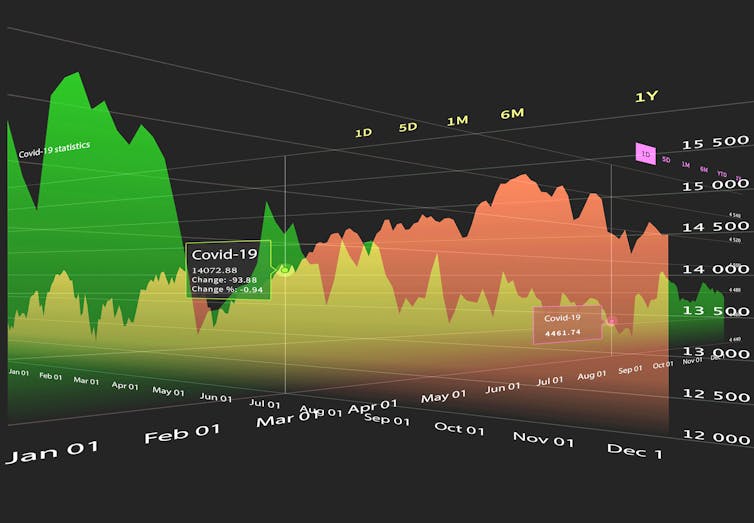An invasive fly could mean the loss of bird species on the Galápagos Islands. To save them, scientists may introduce another invasive insect.
They come at night like a swarm of bogeymen from under the bed. Dozens of hungry fly maggots wriggling up through the maze of a bird’s nest once the chicks — their prey — have nestled in for the night. It’s the maggots’ time to feed, and every night the menu is the same: blood and tissue.
Newly hatched maggots take up temporary residence in a chick’s nostril or ear canal, or under a feather quill, all prime places to find blood. More mature maggots linger in the nest, harassing the chicks from below. These larger fly larvae dine until morning and then squirm back into the entwined twigs where they wait until night comes again.
In the end, chicks may lose anywhere from 18 to 55 percent of their blood during these nightly raids. On average, more than half of the nestlings in an infested nest die because of fly larvae. Those that do survive are often left with a permanent reminder of their battle—a hole in their beak.
The night-marauding larvae of the parasitic fly Philornis downsi are known to scourge birds in Brazil, Argentina, Trinidad and Tobago, and parts of Central America. Common targets include nestlings of the rufous-tailed jacamar and the smooth-billed ani, which have evolved to tolerate the pest. But on the Galápagos Islands, over 550 miles from the fly’s native home on mainland Ecuador, birds are defenseless.
Galápagos birds are no strangers to invasive species. Since the islands were discovered in 1535, more than 1,500 foreign species have found their way there — some accidentally introduced, others intentionally. Among those that persist are 810 plants, 27 vertebrates, 499 insects and 70 other land invertebrates. But few have threatened the birds as much as this fly, and even fewer have invaded the remote isles with such virulence.
Flies have now infected nests of every land bird species on the four inhabited Galápagos islands , says Sonia Kleindorfer, an evolutionary biologist at Flinders University in Australia. That includes the islands’ most famous and iconic birds: Darwin’s finches — a “world heritage system that shaped human thought about how life evolved on planet Earth” that is now under threat, says Kleindorfer.
Survey data show that finches with the highest density of the parasite are suffering dramatic declines, Kleindorfer notes. If nothing is done, “it’s likely that bird populations will become extinct on different islands in the next decades.”
In 2012, scientists founded an organization called the Philornis Working Group to coordinate their efforts to solve the problem. In early 2018, more than two dozen members of the group, hailing from 15 institutions around the globe, gathered in the Galápagos to discuss progress, new findings and a way to save these birds and preserve the islands’ ecosystem.
And, ever the biologists, they hope to use the crisis as an opportunity to learn more about the impacts of invasive species and how the dynamics of host-parasite relationships may alter evolution.
“It’s a kind of laboratory for studying host defense and parasite virulence,” says Dale Clayton, an evolutionary biologist at the University of Utah who has studied this epidemic for the past decade. Studying the battle between bird and fly, then, isn’t just about rescuing a group of birds. The Galápagos have offered yet again a natural experiment, Clayton says, by which scientists can learn how nature works.
Reading the beak
The Galápagos finches comprise 18 related species (depending on how you divide them up — some only recognize 14) across 19 islands. Finches may be best known for the diversity of their beaks, which are adapted for specific diets or skills. The large ground finch, for example, has a short, stout beak for crushing seeds like a nutcracker. The woodpecker finch has a long, broad beak for drumming on trees and using twigs or cactus spines to pry out insects hidden under bark. And the green warbler-finch has a tweezer-like beak for snatching insects.
Darwin was the first to note these beak differences, which later inspired his theory of evolution by natural selection, and they still dazzle researchers today. For the past 80 years, scientists have scrupulously measured and documented the beaks of Darwin’s finches, literally watching the birds evolve. And their meticulous records also helped deduce something else: when the P. downsi fly arrived.
In a 2016 study, Kleindorfer and a colleague compared the nostril sizes of small ground finches and medium tree finches — regular targets of the flies — measured between 2004 and 2014 with those of museum specimens collected between 1899 and 1962, roughly the year when scientists suspect the fly arrived. In each year’s group of birds measured this century, at least a few carried signature holes in their beaks. In specimens collected before 1962, the scientists found none.
That finding lined up fairly well with the first recorded sightings of the fly in 1964, when scientists on the Galápagos reported it buzzing around Santa Cruz Island. They caught and collected eight flies that year, but nobody thought anything of it. Surveys done decades later, though, showed that the fly had spread to other islands. Then in 1997, the first maggots were found lurking in the nostrils of two woodpecker finch nestlings, and the fly’s parasitic nature revealed itself.
It’s unclear how the flies first arrived. Boats, planes and imported animals, plants or fresh produce — means that brought other invasive species — have all been suggested. Another suspect is the smooth-billed ani, a known host of the fly. The ani was deliberately introduced to the Galápagos in the 1960s in a misguided attempt to control ticks on cattle (the birds eat insects as well as vertebrates such as frogs).
Whatever the introduction route, the fly’s invasion has been swift, in biological terms. In less than 60 years, the flies have invaded 13 of the 15 islands surveyed and have infected every species of land bird that scientists have looked at. Some species, like the medium ground finch, have been dramatically affected. “One year — of the nests we were studying — not a single nest produced a single offspring that fledged from the nest,” Clayton says.
At least the medium ground finch population, which the International Union for Conservation of Nature considers of “least concern,” has been able to maintain a stable population despite the fly’s attack. The situation is far more critical for a few highly threatened species. The medium tree finch, with only about 2,500 individuals left, and the mangrove finch, estimated at 100 or less, consistently fall victim to a high density of fly larvae. Mangrove finches lost 14 percent of their young to flies between 2007 and 2008. If this continues, scientists estimate that these birds will be gone in roughly 50 to 100 years. “We’re looking at the probable extinction of the first species of bird in the Galápagos,” Clayton says.
Learning from the arms race
Parasites generally live in a constant balancing act. They infect their hosts for food, and that may kill the hosts. The trick is to not kill hosts too soon, and certainly not to kill them all. Otherwise, the parasites might not survive either.
Yet the flies right now are teetering toward that side — presumably, Clayton says, because they are new to the islands. “The hosts,” he says, “are sitting ducks.”
Birds in P. downsi’s native habitat have evolved ways to avoid, tolerate or adapt to the pest and its approximately four dozen other parasitic fly relatives. Some birds, such as Costa Rica’s white-throated magpie jay, start their breeding season before the fly’s breeding season. Other birds have decreased the number of eggs that they lay, perhaps so they can feed more to each chick to compensate for blood loss.
On the Galápagos, however, there has been scant time for bird and fly to coevolve to a sustainable situation, and the birds have proved much more vulnerable. Only a few exceptions exist, such as the Galápagos mockingbird, which seems less affected by fly infections. This may be because mockingbird chicks, when parasitized, beg for food more earnestly.
Aided by fly larva data amassed since 1997, scientists now have a rare opportunity to study how bird and fly adapt to each other. Ecological theory predicts that epidemics like this will end if the host evolves defenses, says Kleindorfer. But it’s an open question how quickly that can happen.
In the Galápagos bird-fly system, scientists have already seen some changes. In 2012, scientists saw finch species rubbing themselves with leaves from guayabillo trees, plants with natural repellents that ward off mosquitoes and, it turns out, P. downsi larvae. Video recorders placed within nests revealed chicks climbing on top of one another to avoid the larvae, often leaving the weakest of them to be the targeted victim.
Kleindorfer and five of her colleagues documented a new hybrid tree finch species on Floreana Island in a 2014 paper. The hybrid bird, a cross between the critically endangered medium tree finch and the common small tree finch, showed fewer fly infestations than either parent species. The hybrid’s numbers are increasing: They represented 19 percent of tree finches in 2005 and 49 percent in 2014.
The flies have also responded. In 2012, scientists noticed fly larvae in nests when female birds were still incubating their eggs. The flies were laying their own eggs earlier, so instead of the larvae just feeding on the blood of chicks, they also fed on the mother bird.
It’s hard to predict what will ultimately happen, Clayton says. Many factors could lead to either bird or fly gaining the upper hand. But with the fly right now in the lead, some researchers are finding ways to intervene.
The extermination order
Among the attendees at the Philornis Working Group meeting in February was George Heimpel, an entomologist from the University of Minnesota. He was there to discuss one thing: how to eliminate the fly.
Numerous eradication methods have been considered, including the release of sterilized male flies and the setting of fly traps. In 2013, a few clever biologists coated cotton balls with the insecticide permethrin, then offered the cotton to birds building their nests. Permethrin kills fly larvae and leaves the birds unaffected, but it’s a short-term solution, Heimpel says — possibly a dangerous one. Permethrin lasts for a single finch breeding season, but eliminating all the flies would take years and entail repeated use of permethrin. That might kill the island’s endemic insects, Heimpel says. The consequences of exposing birds to the pesticide over many years are unknown.
Instead, Heimpel suggests an unusual solution that he thinks will be most effective: Introduce the fly’s own parasitic enemy, a parasitoid wasp. These wasps target the larvae of another species, such as a spider or fly, and inject eggs into the growing larva or the larval cocoon. The wasps then hatch and feast on the developing larvae.
For the past six years, Heimpel and his team have investigated the behavior of Conura annulifera, a parasitoid wasp found on mainland Ecuador. Heimpel started studying the wasp in 2012 because rumor had it that the wasp parasitized only the larvae of P. downsi. Between 2015 and 2017, Heimpel and his students performed lab and field studies to confirm this favoritism. They offered the wasps larvae from many kinds of flies, moths and other insects in addition to P. downsi larvae, then collected the larvae and let them pupate into adults.
Many insects emerged from the pupae, but C. annulifera emerged from only one: P. downsi, confirming that the wasps target these flies alone. “Those pupae all look about the same to us,” Heimpel emphasizes. But not to this little wasp, he says.
The wasp’s specialization holds promise for removing the fly, but the irony of purposely introducing another species to eliminate an accidental one is hard to miss. “At this stage, there’s no other alternative,” says Mark Hoddle, an entomologist at the University of California, Riverside. The parasitoid wasp “offers the best chance for finding a sustainable, highly targeted solution to this seemingly intractable pest problem.”
Hoddle’s own team released an Australian ladybug species on the islands starting in 2002 to help curb the plant-decimating appetite of the cottony cushion scale insect, another Australian native. The ladybug was known to especially target the scale insect, and after years of quarantined tests to verify this fact and confirm that it wouldn’t cause undesired impacts on other Galápagos species, the bug was finally introduced. After seven years, the scale insect population dropped between 60 and 98 percent.
Heimpel and his team are now applying for permits to perform similar quarantined experiments with the parasitoid wasps. If all goes well, the wasps will be released into the wild within a few years. “Our job is to think very deeply about the risks and to only contemplate a release if the risks are much lower than the benefits,” says Heimpel. After all, if nothing’s done, the risk is tremendous: losing Darwin’s iconic finches.
Editor's note: This story was updated on May 24 to correct an error and to clarify concerns over permethrin and an experiment with wasp larvae. George Heimpel expressed concern over permethrin's effects on insects, not on crabs or spiders, as the story originally said.















